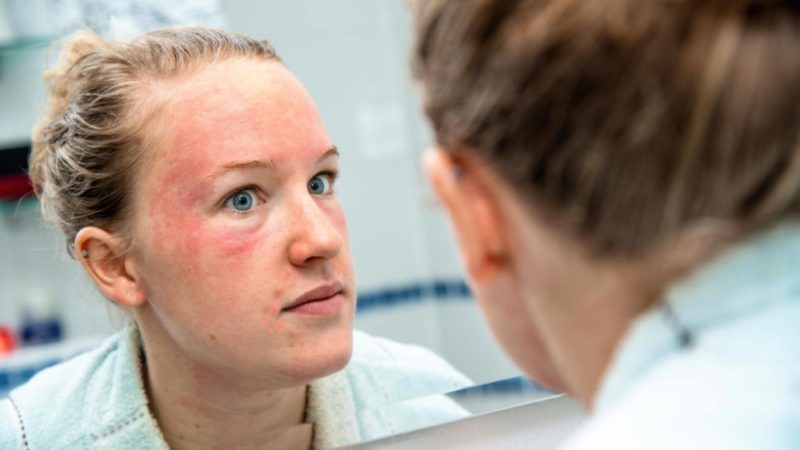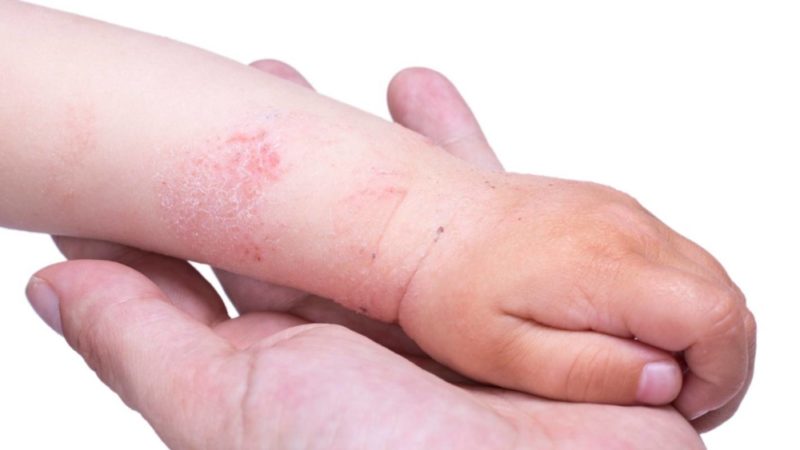The body in childhood often produces atypical reactions to contact with certain products, substances, microorganisms. Allergic urticaria is a popular phenomenon in babies. Most often, it develops in infants during the introduction of the first complementary foods. It is characterized by the appearance of red itchy spots, sometimes even blisters, outwardly somewhat similar to insect bites.
Material Content:
Description of allergic urticaria
The disease got its name not by accident, because in its course the skin becomes covered with red spots or even blisters. In childhood, the disease is more common, since the baby still has imperfect protective mechanisms that stop the effect of certain products and substances. Gradually, the disease reminds itself less and less.
Among all types of urticaria, chronic or idiopathic is considered the most difficult to treat. As a rule, it is accompanied by severe symptoms.
Sometimes you can come across the scientific name for pathology. In medicine, it is called urticaria or dermatitis.
The main types and causes of development
An allergic reaction by the type of urticaria can be expressed differently, as a result of which several types of the disease were distinguished:
- Chronic - a disease with relapse. That is, urticaria either disappears or reappears. This phenomenon can be observed for several years.
- Sharp - the name itself speaks for itself. The skin is burned as if nettles. Symptoms are increasing.At first, a feeling of irritation appears, then itching and inflammation can occur. Rashes can be of the most varied nature. They can be both point-like and merge into a single spot of various sizes. Other symptoms include fever, fever, chills. Statistics say that this type of urticaria is diagnosed in 75% of cases.Quincke's edema is another manifestation of the disease, which is also called the giant urticaria.
- Symptoms occur suddenly and increase rapidly. Itching of the skin practically does not decrease, later there is swelling of the mucous membranes and skin. Allergy sufferers need to have antihistamines with them, this will avoid serious consequences.
- Recurrent. Its distinguishing feature is large blisters that occur in any area of the skin. The disease is accompanied by fever, headache and muscle pain, general weakness.
- Pseudo-allergic. Background disease, the manifestation of which will talk about problems with the digestive system.
Most often, urticaria is manifested in people who have a tendency to allergic reactions.
The main causes of the development of the disease include:
- individual intolerance to certain drugs;
- parasites in the body;
- household dust;
- weakened immunity after infectious diseases;
- foods that contain a high concentration of allergens;
- plants that can cause allergies;
- reaction to insect bites;
- ultra-violet rays.
Signs and symptoms of ailment
The main symptoms of urticaria, which you somehow pay attention to, are rash and swelling.
Other signs include:
- blisters - appear on the skin, have clear boundaries, resemble traces of an insect bite;
- itching of the skin is one of the most unpleasant symptoms;
- skin irritation and peeling.
Despite the fact that urticaria is a safe disease, there are cases where immediate medical attention is required:
- An increase in local temperature in the area of muscles and joints.
- Shortness of breath, difficulty swallowing.
- High heart rate.
Diagnosis of the disease
If you find a rash of any nature in your baby, it is best to immediately consult a specialist for advice. If the diagnosis is “urticaria”, then it is necessary to take tests to determine the allergen.
Now there are several proven methods aimed at establishing the cause of the rash.
Each of them differs both in cost and in the nature of the conduct:
- Skin tests - during the procedure, allergens are applied to the skin.
- Blood test for IgE. This method allows you to check several tens of allergens at a time.
- Provocative tests. Various allergens are introduced into the body, and their reaction is monitored. This analysis is carried out under the strict guidance of specialists.
Methods for the treatment of allergic urticaria
Before starting treatment, you need to undergo a thorough examination. Diagnosing the disease is not difficult.
Most often, a person notices a peculiar reaction of the body after consuming some new product.
After the specialist is diagnosed, treatment is prescribed. To achieve the fastest results, you will need medications, traditional medicine and a special diet.
First of all, it is necessary to exclude products that can cause an allergic reaction. Then, drugs that restore the body are used.
The most famous drugs include:
- Means, the action of which is aimed at blocking the production of histamine - "Zodak", "Claritin", "Loratadin." With the help of drugs, you can reduce itching and relieve swelling.
- Enterosorbents - their action is aimed at removing toxins from the body.
- If the child has digestive disorders, then funds can be prescribed to restore the microflora - Linex, Acipol, etc.
- Remedies for edema.
- With the help of ointments, creams and gels, itching and inflammation can be reduced.
- If it is not possible to achieve the desired result, then hormone-containing drugs are prescribed.
The selection of drugs occurs individually. In no case do not pick up the drugs yourself, as this can lead to an aggravation of the situation.
Folk remedies for the treatment of allergic urticaria in children:
- Prepare a decoction of birch, nettle, needles and wormwood. This tool helps relieve inflammation and itching.
- To improve digestion and restore bowel function, pour 2 tbsp. l bran with hot water. The mixture must be consumed in the morning on an empty stomach.
- Daily intake of licorice root is allowed.
- Wipe itchy places with baking soda diluted in water.
Nutrition recommendations
It is advisable that the dietician prescribe the child's diet. If treatment of allergic urticaria occurs in a hospital setting, fasting for several days may be suggested. The daily amount of fluid consumed should be about 1.5 liters. Additionally, cleansing enemas are prescribed.
The diet for urticaria implies the gradual introduction of new products into the diet, 2 days are allocated for the development of each of them. If the rashes are chronic, then fish, milk and meat are prohibited.
All semi-finished products and mayonnaises should also be excluded from the children's diet. Prefer homemade food. After the allergen is precisely established, it simply needs to be excluded from the diet.
Prevention
If your child is prone to allergic reactions, then preventive measures are extremely necessary for him:
- Work to strengthen the immune system and try not to use drugs
- if pets are kept in the house, make sure that they are vaccinated and protected from parasites;
- try so that the child does not come into contact with either external or internal stimuli;
- protect the baby from all kinds of stress;
- do not “run” colds, all treatment should be carried out in a timely manner;
- introduce new foods gradually, watch for the reaction of the body;
- all insect bite sites should be carefully treated;
- introducing complementary foods to small children, follow all the recommendations of the pediatrician.
Allergic urticaria is an unpleasant skin disease, but with timely assistance, it does not have any serious consequences. Despite the fact that it almost always goes away without medical intervention, the help of a specialist will not hurt, because this is how you can establish the true allergen.















